Serviços Personalizados
Journal
Artigo
Indicadores
-
 Citado por SciELO
Citado por SciELO -
 Acessos
Acessos
Links relacionados
-
 Similares em
SciELO
Similares em
SciELO
Compartilhar
Revista de Ciências Agrárias
versão impressa ISSN 0871-018X
Rev. de Ciências Agrárias vol.41 no.2 Lisboa jun. 2018
https://doi.org/10.19084/RCA17276
ARTIGO
Characterization of Schizolobium parahyba (Vell.) S.F. Blake and Eucalyptus urophylla S.T. Blake juvenile wood in Brazilian Savanna soil
Caracterização da madeira juvenil de Schizolobium parahyba (Vell.) S.F. Blake e Eucalyptus urophylla S.T. Blake em solo de CerradoBrasileiro
Paloma Maria de Moura Rodrigues1, Ademilson Coneglian1, Macksuel Fernandes da Silva2, Mariana Dianese Alves de Moraes2 and Carlos Roberto Sette Junior2,*
1Universidade Estadual de Goiás (UEG),Departamento de Engenharia Florestal, Campus Ipameri, Ipameri, Goiás, Brasil
2Universidade Federal de Goiás (UFG),Departamento de Engenharia Florestal, Rodovia Goiânia-Nova Veneza, Campus Samambaia, Goiânia, Goiás, Brasil
(*E-mail: rsettejr@hotmail.com)
ABSTRACT
The need to understand variations of wood characteristics in alternative species that have fast growth and good quality for the consumer market has been increasinggiven the prominent technological development of wood.This study aimed to evaluate the wood basic density and the anatomical characteristics of Schizolobium parahyba and Eucalyptus urophylla 3-year old juvenile wood planted in savanna soil in a 3x3m spacing.Wood disks were cut in different longitudinal (base-top) and radial (pith-bark) positions from five trees per species to determine the woodsbasic density and fiber and vessel dimensions. The Schizolobium parahyba wood presented (i) lower basic density, vessel size and vessel frequency, and (ii) higher wood fiber width and diameter than Eucalyptus urophylla. The average wood basic density was 0.27 g/cm³ for S. prahyba and 0.40 g/cm³ for E. urophylla wood.
Keywords:Anatomical characteristics, wood density, fast growing species, Guapuruvu, Eucalyptus.
RESUMO
Face ao desenvolvimento tecnológico da madeira, cresce a necessidade do conhecimento sobre a variação das características da madeira de espécies alternativas, de rápido crescimento e de boa qualidade para o mercado consumidor. O presente trabalho teve como objetivo avaliar a densidade básica e as características anatômicas da madeira de Schizolobium parahyba em comparação com o Eucalyptus urophylla, aos 3 anos de idade, plantados em solo de cerrado com espaçamento de 3x3m. Para as análises foram selecionadas 5 árvores/espécie e cortados discos de madeira em diferentes posições longitudinais e radiais (medula-casca) para a determinação da densidade básica e dimensões das fibras (comprimento, espessura da parede, largura total e diâmetro do lume) e dos vasos (frequência, diâmetro tangencial e percentagem de área ocupada). A análise comparativa das características indicou: (i) menor densidade básica e dimensão e frequência dos vasos e (ii) maior largura e diâmetro do lumem das fibras na madeira do S.parahybaem relação a de E.urophylla. A densidade básica média foi de 0,27 g/cm³ para o S. parahyba e de 0,40 g/cm³ para o E. urophylla aos 3 anos de idade.
Palavras-chave: Características anatómicas; densidade da madeira; espécies de rápido crescimento; Guapuruvu, Eucalyptus.
INTRODUCTION
Brazil occupies the second position in the world ranking of forest area with a total of 520 million hectares (12.9% of the forests worldwide) (FAO, 2011) and planted forests total an area of 7.8 million hectares, of which 5.6 million hectares are species of the genus Eucalyptus (IBÁ, 2017). Eucalyptus species are the most productive in the Brazilian forest sector with an average yield of 41.3 m³.ha-1.year-1, a result of targeted investments mainly in genetic improvement, soil preparation and tree fertilization (ABRAF, 2013). Despite the prevalence of eucalyptus species, the forestry sector has directed investments to research studies carried out with native species. The use of native species has been gaining ground, as the market is increasingly seeking alternative species with rapid growth, high productivity and good adaptation to soil conditions.
Paricá (Schizolobium amazonicum) is highlighted among fast-growing native speciesand has been planted commercially, mainly in the North and Center-West of Brazil, reaching 87,500 ha of commercial crops (ABRAF, 2013). Guapuruvu (Schizolobium parahyba) is also considered one of the fastest growing native species. The wood (0.24g/cm3 to 0.40g/cm3) is of lownatural durability, indicated for manufacturing furniture (after chemical treatment) and compensated panels, and presents volumetric growth rate of up to45 m³.ha-1.year-1 at 10 years of age (Nisgoskiet al., 2012).
The growing demand for timber in domestic and foreign markets tends to favor replacing native wood by juvenile reforestation wood, which has become more evident in recent years. Researchers and the industrial sectorsinterest in juvenile wood rotations is growing and the use of this wood causesproblems associated with fiber quality and low physical-mechanical properties (Vidaurreet al., 2011).
Evaluating the anatomical and physical characteristics of the wood is fundamental to define its correct application in the many industrial uses. Basic density is the main measure for wood quality assessment, which along with anatomical characteristics are intrinsic properties that vary among species, individuals and positions in the trunk (pith-bark; base-top) (Trugilhoet al., 2009).
This study aimed to determine the basic density and the anatomical characteristics of S. parahyba and E. urophyllaj uvenile woodboth planted in Cerrado soil.
MATERIAL AND METHODS
Study site
The trees were cut down from a forest stand at the State University of Goiás, Ipameri Campus, GO (17° 42 38 S, 48° 08 12 W, 825 m height). The climate of the region is classified as tropical with dry winter and wet summer (Aw) according to Köeppen, with an average annual precipitation of 1,447 mm and a mean temperature of 21.9°C. The soil is classified as Oxisol with a clayeytexture.The anatomical characteristics and wood density were evaluated in the Bioenergy and Wood Quality Laboratory (LQMBio )of the Federal University of Goiás, Goiânia, GO.
Field experiment
The forest stands were implemented in June 2013 and made up of S. parahyba( Vell) S.F. Blaketrees (seeds from Pederneira-SP) planted in 0.5 hectares spaced 3.0 m x 3.0 m, and E. urophylla S.T. Blake plots (seeds from Anhembi-SP) planted in 0.2 hectares spaced 3.0 m x 3.0 m. Trees of both species received chemical fertilization with 180 g of NPK formulation 5-30-15 + 0.2 Zn + 0.5 B per pit. The same fertilization was replicated in the coverage in the amount of 110g per plant at 6, 12 and 18 months after planting.
Collection, cutting and sample preparation
Five Guapuruvu and five Eucalyptus trees, 3 years-old, were randomly selectedand harvested. Two cross-sectional discs, 5 cm thick, were cut down from each tree along the stem at different height levels (0, 25, 50, 75 and 100% of the commercial height) as shown in Figure 1, to determine fiber(length, wall thickness, lumen diameter and overall width) andvessels (tangential diameter, frequency and occupied area)dimensions and basic density.
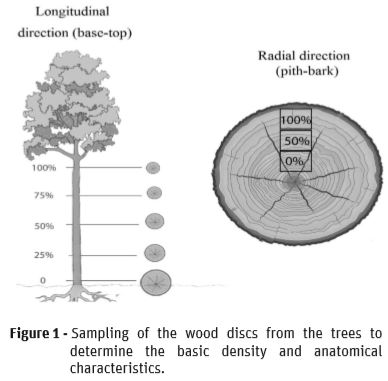
Wood basic density
For wood basic density, one disck per position collected was immersed in water until completely saturated. Then the wet weight (Ww), immersed weight (Pi) and dry weight (Ps) up to constant weight (103°±2°C) were obtainedfollowing the method proposed byVital (1984). The wood basic density values per longitudinal position were used to determine the arithmetic mean by tree and after by species and thebase-top variation.
Anatomical characteristics of wood
Radial samples of the wooddiscs were collected fromthree positions (0%; near to pith, 50%; intermediate region and 100%; near to bark) and were macerated according tothe Franklin method (Johansen, 1940). Histological slides were prepared from the fiber suspensionby collecting 15 images/slide under a light microscope to measure its length(magnified by 100x), and 15 images/slide for width, lumen diameter and wall thickness(magnified by 400x). Specimens (20 x 10 mm width x thickness) were taken from the same wood samples used in the maceration process (three radial positions; 0, 50 and 100%), and were soaked in boiling water for saturation and softening. These specimens were fixed on microtome slides and cross-sections werecut (15-20 μm thick). Histological sections of the wood werebleached (Javel water), washed (distilled water, acetic acid 1%), dehydrated (alcoholic series, 30-100%), washed (xylol) during 30 min. and then the histological slides were mounted in Canada balsam.
Digital imagesof transverse section (3 per radial position) were collected from slides prepared under fluorescence microscopy (40x) to measure vessel diameter, % area occupied per vessel and vessel frequency according to theIAWA (1989). Image Pro Plus software was used to measure the anatomical variables.
Statistical analyzes
A completely randomized design was used for statistical data analysis. From the data obtained, the outliers were checked by the Box-Plot method, the distribution normality by the Shapiro-Wilk method and the variance heterogeneity by the Bartlett and Levene methods. The data presented normality of distribution and homogeneity of variance, and analysis of variance (ANOVA) was applied, verifying the effect of the species and the radial and longitudinal position on the wood basic density and anatomical characteristics. A regression analysis was carried out to assess the relationshipbetween variables andlongitudinal positions.
RESULTS AND DISCUSSION
The wood basic density averages of 3-year-old E. urophylla and S. parahyba were significantly different, as shown in Table 1.
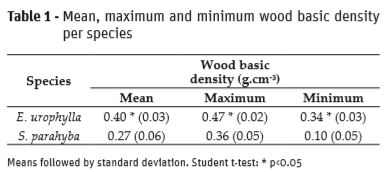
The Eucalyptus wood basic density observed in this study is in agreement withthe values referenced byGouvêa et al. (2011) of 3-year-old Eucalyptus sp. clones with maximum and minimum densities ranging from0.41to 0.47g.cm-3 and by Sette Jr et al. (2012) for E. grandisat 2, 4 and 6-years old (0.43, 0.44 and 0.46 g.cm-3, respectively).
In studying 16-year-old E. urophylla, Oliveira et al. (2005) obtained values of 0.54 g.cm-3; 25% higher than those found in this study. The differences in mean wood basic density values are associated with juvenile and adult wood and to the age of the trees. The effect of increasing tree age on wood quality (including basic density) has been reported in the literature by many authors and for several forest species (Zobel and van Buijtenen, 1989; Trugilho et al., 1996; Silva et al., 2007; Sette Jr .et al., 2012), and states that the increase in wood density occurs due to changes in the cambial meristemand to the mechanical-physiological requirements consequent of the tree developmentprocess. Such processes arerepresented by increased wall thickness of the fibers and increased frequency and reduced number of vessels, as the mature wood is formed in the treetrunks.
Scientific studies that have evaluated the characteristics of S. parahyba wood are scarce :Andrade and Carvalho (1998) evaluated trees from native vegetation and found basic density values of 0.24 g.cm-3, while Athanázio-Heliodoro (2015) evaluated the characteristics of S. parahyba wood and obtained mean basic density values of 0.29 g.cm-3 in 15-year-old trees.
The analysis of variance indicated a significant sampling position in base-top direction effect in the tree trunks for wood characteristics. Regarding wood basic density, a quadratic variation models was observed for both species, with variation patterns different (i) Eucalyptus: decreased from the base up to approximately 50% of the commercial height, remaining constant or increasing towards the top of the trunk and (ii) Guapuruvu: characterized by a decrease in average wood basic density values from the base (0.28-0.39g.cm-3) to the top (0.10-0.20 g.cm-3) (Figure 2).
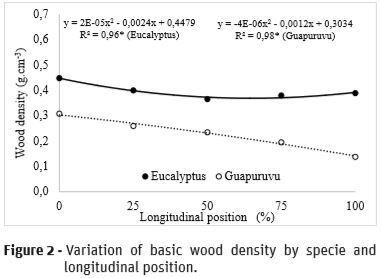
This longitudinal variation of the wood basic density in the tree trunks is similar to those recorded byPanshinand De Zeeuw (1980) and Zobel and Van Buijtenen (1989), who highlight some patterns where the values and behavior of the wood basic density in the longitudinal position will vary depending on age and species.
The higherwood basic density values in the basal region in both species are related to the highest value of fibre wall thickness (Guapuruvu) and the lowest values of tangencial diameter and area ocuppiedby vessels (Eucalyptus).The longitudinal increase of wood density observed in forest speciesisrelated tothe increase of fibre wall thickness from the base to the topand a possible variation of vessel dimensions and percentage (Quilhó and Pereira, 2001).
There was no significant effect of species in fiber length and wall thickness, with an average length of 873.5 and 869.2 µm and wall thickness of 3.9 and 3.7 µm for Eucalyptus andGuapuruvu, respectively. The Guapuruvu presented higher fiber width and lumen diameter i.e 29.4 μm and 22.0 μm respectively versus 19.8 μm and 11.8 μm in Eucalyptus (Table 2).
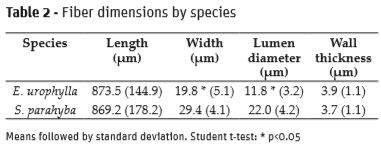
The values recorded for fiber dimensionsin this paper are within the range established by the literaturefor trees from 2 to 20 years: 750 to 1400 μm, 12 to 20 μm, 2.5 to 6.0 μm and 6 to 12 μm for length, width, wall thickness and lumen diameter (Bamber et al., 1982; Silva et al., 2007; Sette Jr et al., 2009).
A shortage of scientific studies evaluating the anatomical characteristics of Guapuruvu wood, especially juvenile wood in young trees, make it difficult to discuss the results. In 15-year-old Guapuruvutrees ,the length, width, wall thickness and lumen diameter of fibers were 1035.0, 37.9, 3.8 and 30.6 μm, respectively(Nisgoski et al., 2012). The mean values of fiber dimensions were smaller than previous records in this study and as mentioned earlier this difference is related toalready-formed mature wood.
The fiber dimension variation in the three radial positions of 3-year-old Eucalyptus and Guapuruvu treesis shown in Figure 3.
For both tree species, the length and wall thickness of the fibers increased significantly (p <0.05) from the region near the pith to bark and the width and lumen diameter of fibers decreased, althought only significantely for Guapuruvu.
There is vast literature concerning the radial variation of wood fiber dimensions in the radial direction of wood in various species and different growth conditions. For eucalyptus species several patterns of radial variation have been reported, showing an increase of length and wall thickness and a reduce fiber width and lumen diameter from the pith to the bark (Tomazello Filho, 1985; Jorge et al., 2000; Quilhó et al., 2006; Silva et al., 2007; Sette Jr. et al., 2009).
Nisgoski et al. (2012) verified an increase in length, wall thickness, width and lumen diameter of fibers in the pith-bark direction in 15-year old S. parahyba, and Lobãoet al. (2012) in 21-year old S. parahyba var. amazonicum.
The analysis of variance indicated a significant effect of base-top direction in the tree trunks for anatomical characteristics. Regarding fiber dimensions, a quadratic variation models was observed for both species with similar variation patterns, except for length and coefficient of determination, ranging from 0.61 to 0.92 (Figure 4).
The fibers of two species had thicker walls at the base (4.12 - 4.13 μm) than the other longitudinal positions (25, 50, 75 e 100%; 3.26 to 4.06 μm).In general, an increase in the width and diameter of the cell lumen near the base towards the top of the tree was observed (Figure 4).
The literature does not present data on the variation of anatomical characteristics in S. parahyba wood in the longitudinal direction. However, some studies show different patterns of variation of the fiber dimensions from the base to the top (Sette Jr. et al., 2012; Gonçalez et al., 2014) for other forest species, including Eucalyptus, as also observed in this study.
The vessel dimensions and frequencies differed significantly among the species, with higher mean values observed for E. urophylla (Table 3): the frequency, tangential diameter and occupied area of vessels was higher in Eucalyptus than in Guapuruvu wood.
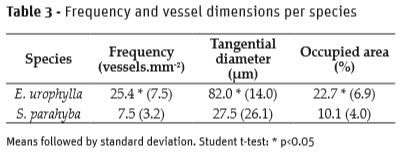
The radial variation pattern of vessel frequency and dimensions (Figure 5) were similarto that of previous studies carried out with several species: increased vessel diameter and reduced frequency in pith-bark direction (Rocha et al., 2004; Sette Jr. et al.,2012). In the physiological aspect, changes in diameter, frequency and arrangement of vessels are interpreted by the need of the plants to increase their capacity of transporting water and minerals as their growth is increased and consequently their size increases. Under the technological aspect these changes reflect the physical-mechanical properties of wood, on drying and on the penetration of liquor in the chips during the delignification process.
The wood at the base of the trunk presented vessels with lower frequency, tangential diameter and area occupied than in other parts of the trunk, with a tendency to increase the values toward the top of the tree for both species studied (Figure 6). This result observed for vessels along with that observed for fiber dimensions (Figure 4) affects the wood basic density values: smaller sizes of vessels promote increased in wood density, as previously discussed.
The higher frequency and area occupied by the vessels at the top of the tree may be related to the increase in the physiologically active wood (sapwood; sapflow from roots to leaves) along the trunk in the base-top direction.
The evaluation of Schizolobium parahyba and Eucalyptus urophylla wood at more advanced ages is recommended to determine the variation of its anatomical and physical characteristics, as well as the mechanical properties and chemical characteristics (not contemplated in this study) to characterize the phase of its stabilization (formation of mature wood), which are important for its adequate technological use.
CONCLUSIONS
The comparative analysis of the wood characteristics showed: (i) lower basic density, vessel dimensions and frequency; and (ii) larger width and lumen diameter of the fibers in the Schizolobium parahyba than the Eucalyptus urophylla. The average wood basic density Schizolobium parahyba was 0.27 g.cm-3 and 0.40 g.cm-3 for Eucalyptus urophylla, both at 3 years-old.
The longitudinal and radial variation patterns of the wood basic densityand the anatomical characteristics of 3-year old Schizolobium parahyba and Eucalyptus urophylla trees planted in Brasilian Savanna soilshowed that the cambium is still formingthe juvenile wood.
References
ABRAF (2013) - Anuário estatístico da ABRAF 2012.Associação Brasileira de Produtores de Florestas Plantadas. Brasília, Brasil, 110 p. [ Links ]
Andrade, A.M. & Carvalho, L.M. (1998) - Potencialidades energéticas de oito espécies florestais do Estado do Rio de Janeiro. Floresta e Ambiente, vol. 5, n. 1, p. 24-42. [ Links ]
Athanázio-Heliodoro, J.C. (2015) - Qualidade da madeira de árvores de Guapuruvu(Schizolobiumparahyba (Vell.) Blake) com 15 anos provenientes de área de recuperação florestal. Dissertação apresentada à Faculdade deCiências Agronômicas da UNESP, para obtenção dotítulo de Mestre em Ciência Florestal. 168 p. [ Links ]
Bamber, R.K.; Horne, R. & Graham-Higgs, A. (1982) - Effect of fast growth on the wood properties of Eucalyptus grandis. Australian Forestry Research, vol. 12, n. 2, p. 163-167. [ Links ]
FAO (2011) - Situación de losbosquesdelmundo 2011. Food and Agriculture Organization of the United Nations. Roma. 176 p. [ Links ]
Gonçalez, J.C.; Dos Santos, G.L.; Silva Junior, F.G.; Martins, I.S. & Costa, J.A. (2014) - Relações entre dimensões de fibras e de densidade da madeira ao longo do tronco de Eucalyptusurograndis. ScientiaForestalis, vol. 42, n. 101, p. 81-89. [ Links ]
Gouvêa, A.F.G.; Trugilho, P.F.; Gomide, J.L.; Silva, J.R.M.; Andrade, C.R. & Alves, I.C.N. (2011) - Determinação da densidade básica da madeira de Eucalyptus por diferentes métodos não destrutivos. Revista Árvore, vol. 35, n. 2, p. 349-358. http://dx.doi.org/10.1590/S0100-67622011000200019 [ Links ]
IAWA (1989) – List of Microscopic Features for Hardwood Identification. IAWA Bulletin,vol. 10, n. 3, p. 219-332. [ Links ]
IBÁ (2017) - Anuário Estatístico. Ano base 2013. Indústria Brasileira de Árvores. 100 p. [ Links ]
Johansen, D.A. (1940) - Plant microtechnique. 1º ed., New York: Mc Graw Hill, 523 p. [ Links ]
Jorge, F.; Quilhó, T. & Pereira, H. (2000) - Variability of fibre length in wood and bark in Eucalyptus globulus. IAWA Journal, vol. 21, n. 1, p. 41–48. https://doi.org/10.1163/22941932-90000235 [ Links ]
Lobão, M.S.; Costa, D.P.; Almonacid, M.A.A. &Tomazello Filho, M. (2012) - Qualidade do lenho de árvores de Schizolobiumparahyba var. amazonicum. Floresta e Ambiente, vol. 19, n. 3, p. 374-384. http://dx.doi.org/10.4322/floram.2012.044 [ Links ]
Nisgoski, S.; Muñiz, G.I.B.; Trianoski, R.; Matos, J.L.M. &Venson, I. (2012) - Características anatômicas da madeira e índices de resistência do papel de Schizolobiumparahyba (Vell.) Blake proveniente de plantio experimental. ScientiaForestalis, vol. 40, n. 94, p. 203-211. [ Links ]
Oliveira, J.T.S.; Hellmeister, J.C. &Tomazello Filho, M. (2005) - Variação do teor de umidade e da densidade básica na madeira de sete espécies de Eucalipto. Revista Árvore, vol. 29, n. 1, p. 115-127. http://dx.doi.org/10.1590/S0100-67622005000100013 [ Links ]
Panshin, A.J. & De Zeeuw, C. (1980) - Textbook of wood technology.4. ed., Mc-Graw-Hill, New York, 722 p. [ Links ]
Quilhó, T.; Miranda, I. & Pereira, H. (2006) - Within and between tree variation of fibre biometry and wood density of Eucalyptus grandis x Eucalyptus urophylla. IAWAJournal, vol. 27, n. 3, p. 243-250. https://doi.org/10.1163/22941932-90000152 [ Links ]
Quilhó, T. & Pereira, H. (2001) - Within and between tree variation of bark content and wood density of Eucalyptus globulus in commercial plantations. IAWA Journal, vol. 22, n. 3, p.255-265. https://doi.org/10.1163/22941932-90000283 [ Links ]
Rocha, F.T.; Florsheim, S.M.B. & Couto, H.T.Z. (2004) - Variação das dimensões dos elementos anatômicos da madeira de árvores de EucalyptusgrandisHill ex. Maiden aos sete anos. Revista do Instituto Florestal, v. 16, n. 1, p. 43-55. [ Links ]
Sette Jr, C.R.; Oliveira, I.R.; Tomazello Filho, M.; Yamaji, F.M.; Laclau, J.P. (2012) - Efeito da idade e posição de amostragem na densidade e características anatômicas da madeira de Eucalyptusgrandis.Revista Árvore, vol. 36, n. 6, p. 1183-1190. http://dx.doi.org/10.1590/S0100-67622012000600019 [ Links ]
Sette Jr, C.R.;Tomazello Filho, M.; Lousada, J.L.P.C.&Laclau, J.P. (2009) - Efeito da aplicação de fertilização nitrogenada e lodo de esgoto nas características da madeira juvenil em árvores de Eucalyptusgrandis. Cerne, vol. 15, n. 3, p. 303-312. [ Links ]
Silva, J.C.; Tomazello Filho, M.; Oliveira, J.T.S. & Castro, V.R. (2007) - Influência da idade e da posição radial nas dimensões das fibras e dos vasos da madeira de Eucalyptusgrandis Hill ex. Maiden. Revista Árvore, vol. 31, n. 6, p. 1081-1090. http://dx.doi.org/10.1590/S0100-67622007000600013 [ Links ]
Tomazello Filho, M. (1985) - Variação radial da densidade básica e da estrutura anatômica da madeira do Eucalyptussaligna e Eucalyptusgrandis. IPEF, vol. 29, p. 37-45. [ Links ]
Trugilho, P.F.; Lima, J.T. & Mendes, L.M. (1996) - Influência da idade nas características físico – químicas e anatômicas da madeira de Eucalyptossaligna. Cerne, vol. 2, n. 1, p. 17-27. [ Links ]
Vidaurre, G.; Lombardi, L.R.; Oliveira, J.T.S.P. & Arantes, M. D. C. (2011) - Lenho juvenil e adulto e as propriedades da madeira. Floresta e Ambiente, vol. 18, n. 4, p 469-480. http://dx.doi.org/10.4322/floram.2011.066 [ Links ]
Vital, B.R. (1984) - Métodos de determinação da densidade da madeira. Sociedade de Investigações Florestais, Viçosa, 21 p. [ Links ]
Zobel, B.J. & van Buijtenen, J. P. (1989) - Wood variation: its causes andcontrol. Berlin: Springer-Verlag, 361 p. [ Links ]
Received/recebido: 2017.10.30
Received in revised form/recebido em versão revista: 2018.02.12
Accepted/aceite: 2018.02.03














